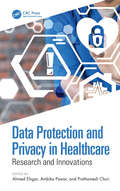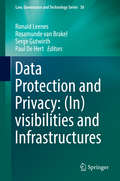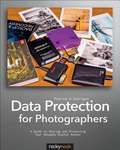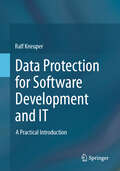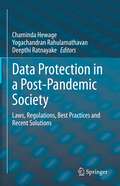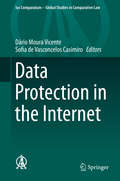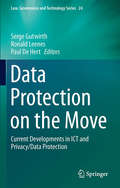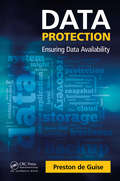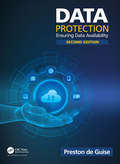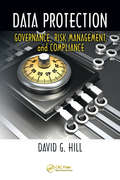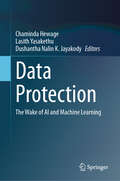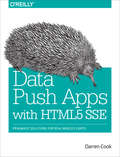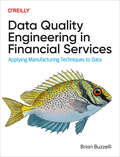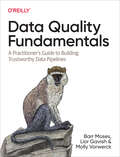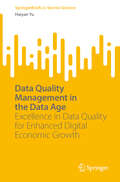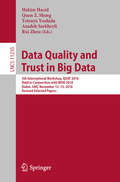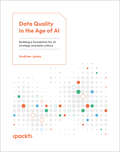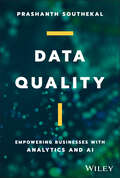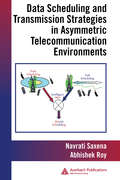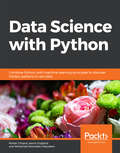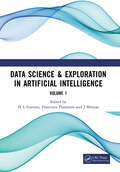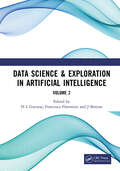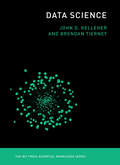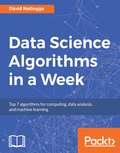- Table View
- List View
Data Protection and Privacy in Healthcare: Research and Innovations
by Ahmed Elngar, Ambika Pawar, and Prathamesh ChuriThe Healthcare industry is one of the largest and rapidly developing industries. Over the last few years, healthcare management is changing from disease centered to patient centered. While on one side the analysis of healthcare data plays an important role in healthcare management, but on the other side the privacy of a patient’s record must be of equal concern. This book uses a research-oriented approach and focuses on privacy-based healthcare tools and technologies. It offers details on privacy laws with real-life case studies and examples, and addresses privacy issues in newer technologies such as Cloud, Big Data, and IoT. It discusses the e-health system and preserving its privacy, and the use of wearable technologies for patient monitoring, data streaming and sharing, and use of data analysis to provide various health services. This book is written for research scholars, academicians working in healthcare and data privacy domains, as well as researchers involved with healthcare law, and those working at facilities in security and privacy domains. Students and industry professionals, as well as medical practitioners might also find this book of interest.
Data Protection and Privacy: (Law, Governance and Technology Series #36)
by Paul De Hert Serge Gutwirth Ronald Leenes Rosamunde Van BrakelThis book features peer reviewed contributions from across the disciplines on themes relating to protection of data and to privacy protection. The authors explore fundamental and legal questions, investigate case studies and consider concepts and tools such as privacy by design, the risks of surveillance and fostering trust. Readers may trace both technological and legal evolution as chapters examine current developments in ICT such as cloud computing and the Internet of Things. Written during the process of the fundamental revision of revision of EU data protection law (the 1995 Data Protection Directive), this volume is highly topical. Since the European Parliament has adopted the General Data Protection Regulation (Regulation 2016/679), which will apply from 25 May 2018, there are many details to be sorted out. This volume identifies and exemplifies key, contemporary issues. From fundamental rights and offline alternatives, through transparency requirements to health data breaches, the reader is provided with a rich and detailed picture, including some daring approaches to privacy and data protection. The book will inform and inspire all stakeholders. Researchers with an interest in the philosophy of law and philosophy of technology, in computers and society, and in European and International law will all find something of value in this stimulating and engaging work.
Data Protection for Photographers
by Patrick H. CorriganAll photographers, both amateur and professional, are faced with the important issues of data protection and storage. Without knowledge of the options, tools, and procedures for safe and effective image protection and storage, photographers run the serious risk of losing their image files. This book offers critical information about the best hardware, software, procedures, and practices for capturing, storing, and preserving images and other data. This book explains current data protection and storage technologies in everyday terms. It describes effective procedures for protecting data, from capture to backup and archiving. Descriptions of specific products applicable to Windows, MacOS, and Linux systems are provided.
Data Protection for Software Development and IT: A Practical Introduction
by Ralf KneuperThis book introduces data protection, i.e. the protection of individuals from misuse of their personal data. It provides a special focus on the direct impact on software development, e.g. in the form of functional requirements for software systems resulting from data protection. Chapter 1 provides an initial overview of the basic concepts of data protection and its legal foundations. Chapter 2 then delves deeper into the European General Data Protection Regulation (GDPR), covering in particular its basic concepts, terminology and requirements. Next, the specific implementation and interpretation of GDPR requirements in software and IT are dealt with, starting in chapter 3 with the principles of data protection defined in GDPR and the rights of data subjects in chapter 4. Chapter 5 discusses data transfer between organizations, including the relevant constellations (e.g. through various service providers), the legal framework and its practical implementation. Subsequently, chapter 6 changes the view from individual regulations and their implementation to technical and organizational design of data protection, including its embedding in the software life cycle, while chapter 7 provides an overview of information security and its aspects relevant to data protection. Eventually, chapter 8 deals with data protection for organizations as they are data subjects themselves. The appendices contain the most important excerpts from the Charter of Fundamental Rights of the EU and GDPR in this context, a collection of links to relevant laws and supervisory authorities, as well as a glossary of the most important terms used. The book’s target groups include software developers, IT consultants, requirements analysts, IT operations personnel and project managers in IT projects, but also data protection managers and data protection officers in the context of software development and IT.
Data Protection in a Post-Pandemic Society: Laws, Regulations, Best Practices and Recent Solutions
by Chaminda Hewage Yogachandran Rahulamathavan Deepthi RatnayakeThis book offers the latest research results and predictions in data protection with a special focus on post-pandemic society. This book also includes various case studies and applications on data protection. It includes the Internet of Things (IoT), smart cities, federated learning, Metaverse, cryptography and cybersecurity. Data protection has burst onto the computer security scene due to the increased interest in securing personal data. Data protection is a key aspect of information security where personal and business data need to be protected from unauthorized access and modification. The stolen personal information has been used for many purposes such as ransom, bullying and identity theft. Due to the wider usage of the Internet and social media applications, people make themselves vulnerable by sharing personal data. This book discusses the challenges associated with personal data protection prior, during and post COVID-19 pandemic. Some of these challenges are caused by the technological advancements (e.g. Artificial Intelligence (AI)/Machine Learning (ML) and ChatGPT). In order to preserve the privacy of the data involved, there are novel techniques such as zero knowledge proof, fully homomorphic encryption, multi-party computations are being deployed. The tension between data privacy and data utility drive innovation in this area where numerous start-ups around the world have started receiving funding from government agencies and venture capitalists. This fuels the adoption of privacy-preserving data computation techniques in real application and the field is rapidly evolving. Researchers and students studying/working in data protection and related security fields will find this book useful as a reference.
Data Protection in the Internet (Ius Comparatum - Global Studies in Comparative Law #38)
by Dário Moura Vicente Sofia de Vasconcelos CasimiroThis book identifies and explains the different national approaches to data protection – the legal regulation of the collection, storage, transmission and use of information concerning identified or identifiable individuals – and determines the extent to which they could be harmonised in the foreseeable future. In recent years, data protection has become a major concern in many countries, as well as at supranational and international levels. In fact, the emergence of computing technologies that allow lower-cost processing of increasing amounts of information, associated with the advent and exponential use of the Internet and other communication networks and the widespread liberalization of the trans-border flow of information have enabled the large-scale collection and processing of personal data, not only for scientific or commercial uses, but also for political uses. A growing number of governmental and private organizations now possess and use data processing in order to determine, predict and influence individual behavior in all fields of human activity. This inevitably entails new risks, from the perspective of individual privacy, but also other fundamental rights, such as the right not to be discriminated against, fair competition between commercial enterprises and the proper functioning of democratic institutions. These phenomena have not been ignored from a legal point of view: at the national, supranational and international levels, an increasing number of regulatory instruments – including the European Union’s General Data Protection Regulation applicable as of 25 May 2018 – have been adopted with the purpose of preventing personal data misuse. Nevertheless, distinct national approaches still prevail in this domain, notably those that separate the comprehensive and detailed protective rules adopted in Europe since the 1995 Directive on the processing of personal data from the more fragmented and liberal attitude of American courts and legislators in this respect. In a globalized world, in which personal data can instantly circulate and be used simultaneously in communications networks that are ubiquitous by nature, these different national and regional approaches are a major source of legal conflict.
Data Protection on the Move: Current Developments in ICT and Privacy/Data Protection (Law, Governance and Technology Series #24)
by Serge Gutwirth Ronald Leenes Paul HertThis volume brings together papers that offer methodologies, conceptual analyses, highlight issues, propose solutions, and discuss practices regarding privacy and data protection. It is one of the results of the eight annual International Conference on Computers, Privacy, and Data Protection, CPDP 2015, held in Brussels in January 2015. The book explores core concepts, rights and values in (upcoming) data protection regulation and their (in)adequacy in view of developments such as Big and Open Data, including the right to be forgotten, metadata, and anonymity. It discusses privacy promoting methods and tools such as a formal systems modeling methodology, privacy by design in various forms (robotics, anonymous payment), the opportunities and burdens of privacy self management, the differentiating role privacy can play in innovation. The book also discusses EU policies with respect to Big and Open Data and provides advice to policy makers regarding these topics. Also attention is being paid to regulation and its effects, for instance in case of the so-called 'EU-cookie law' and groundbreaking cases, such as Europe v. Facebook. This interdisciplinary book was written during what may turn out to be the final stages of the process of the fundamental revision of the current EU data protection law by the Data Protection Package proposed by the European Commission. It discusses open issues and daring and prospective approaches. It will serve as an insightful resource for readers with an interest in privacy and data protection.
Data Protection: Ensuring Data Availability
by Preston de GuiseThis is the fundamental truth about data protection: backup is dead. Or rather, backup and recovery, as a standalone topic, no longer has relevance in IT. As a standalone topic, it’s been killed off by seemingly exponential growth in storage and data, by the cloud, and by virtualization. So what is data protection? This book takes a holistic, business-based approach to data protection. It explains how data protection is a mix of proactive and reactive planning, technology and activities that allow for data continuity. It shows how truly effective data protection comes from a holistic approach considering the entire data lifecycle and all required SLAs. Data protection is neither RAID nor is it continuous availability, replication, snapshots or backups—it is all of them, combined in a considered and measured approach to suit the criticality of the data and meet all the requirements of the business. The book also discusses how businesses seeking to creatively leverage their IT investments and to drive through cost optimization are increasingly looking at data protection as a mechanism to achieve those goals. In addition to being a type of insurance policy, data protection is becoming an enabler for new processes around data movement and data processing. This book arms readers with information critical for making decisions on how data can be protected against loss in the cloud, on-premises, or in a mix of the two. It explains the changing face of recovery in a highly virtualized data center and techniques for dealing with big data. Moreover, it presents a model for where data recovery processes can be integrated with IT governance and management in order to achieve the right focus on recoverability across the business.
Data Protection: Ensuring Data Availability
by Preston de GuiseThe second edition of Data Protection goes beyond the traditional topics including deduplication, continuous availability, snapshots, replication, backup, and recovery, and explores such additional considerations as legal, privacy, and ethical issues. A new model is presented for understanding and planning the various aspects of data protection, which is essential to developing holistic strategies. The second edition also addresses the cloud and the growing adoption of software and function as a service, as well as effectively planning over the lifespan of a workload: what the best mix of traditional and cloud native data protection services might be. Virtualization continues to present new challenges to data protection, and the impact of containerization is examined. The book takes a holistic, business-based approach to data protection. It explains how data protection is a mix of proactive and reactive planning, technology, and activities that allow for data continuity. There are three essential activities that refer to themselves as data protection; while they all overlap in terms of scope and function, each operates as a reasonably self-contained field with its own specialists and domain nomenclature. These three activities are: • Data protection as a storage and recovery activity • Data protection as a security activity • Data protection as a privacy activity These activities are covered in detail, with a focus on how organizations can use them to leverage their IT investments and optimize costs. The book also explains how data protection is becoming an enabler for new processes around data movement and data processing. This book arms readers with information critical for making decisions on how data can be protected against loss in the cloud, on premises, or in a mix of the two. It explains the changing face of recovery in a highly virtualized datacenter and techniques for dealing with big data. Moreover, it presents a model for where data recovery processes can be integrated with IT governance and management in order to achieve the right focus on recoverability across the business. About the Author Preston de Guise has been working with data recovery products for his entire career—designing, implementing, and supporting solutions for governments, universities, and businesses ranging from SMEs to Fortune 500 companies. This broad exposure to industry verticals and business sizes has enabled Preston to understand not only the technical requirements of data protection and recovery, but the management and procedural aspects too.
Data Protection: Governance, Risk Management, and Compliance
by David G. HillFailure to appreciate the full dimensions of data protection can lead to poor data protection management, costly resource allocation issues, and exposure to unnecessary risks. Data Protection: Governance, Risk Management, and Compliance explains how to gain a handle on the vital aspects of data protection.The author begins by building the foundatio
Data Protection: The Wake of AI and Machine Learning
by Dushantha Nalin K. Jayakody Chaminda Hewage Lasith YasakethuThis book provides a thorough and unique overview of the challenges, opportunities and solutions related with data protection in the age of AI and ML technologies. It investigates the interface of data protection and new technologies, emphasising the growing need to safeguard personal and confidential data from unauthorised access and change. The authors emphasize the crucial need of strong data protection regulations, focusing on the consequences of AI and ML breakthroughs for privacy and individual rights. This book emphasizes the multifarious aspect of data protection, which goes beyond technological solutions to include ethical, legislative and societal factors. This book explores into the complexity of data protection in the age of AI and ML. It investigates how massive volumes of personal and sensitive data are utilized to train and develop AI models, demanding novel privacy-preserving strategies such as anonymization, differential privacy and federated learning. The duties and responsibilities of engineers, policy makers and ethicists in minimizing algorithmic bias and ensuring ethical AI use are carefully defined. Key developments, such as the influence of the European Union's General Data Protection Regulation (GDPR) and the EU AI Act on data protection procedures, are reviewed critically. This investigation focusses not only on the tactics used, but also on the problems and successes in creating a secure and ethical AI ecosystem. This book provides a comprehensive overview of the efforts to integrate data protection into AI innovation, including valuable perspectives on the effectiveness of these measures and the ongoing adjustments required to address the fluid nature of privacy concerns. This book is a helpful resource for upper-undergraduate and graduate computer science students, as well as others interested in cybersecurity and data protection. Researchers in AI, ML, and data privacy as well as data protection officers, politicians, lawmakers and decision-makers will find this book useful as a reference.
Data Push Apps with HTML5 SSE: Pragmatic Solutions for Real-World Clients
by Darren CookMake sure your website or web application users get content updates right now with minimal latency. This concise guide shows you how to push new data from the server to clients with HTML5 Server-Sent Events (SSE), an exceptional technology that doesn’t require constant polling or user interaction. You’ll learn how to build a real-world SSE application from start to finish that solves a demanding domain problem.You’ll also discover how to increase that application’s desktop and mobile browser support from 60% to 99%, using different fallback solutions. If you’re familiar with HTML, HTTP, and basic JavaScript, you’re ready to get started.Determine whether SSE, WebSockets, or data pull is best for your organizationDevelop a working SSE application complete with backend and frontend solutionsAddress error handling, system recovery, and other issues to make the application production-qualityExplore two fallback solutions for browsers that don’t support SSETackle security issues, including authorization and "disallowed origin"Develop realistic, repeatable data that’s useful in test-driven SSE designLearn SSE protocol elements not covered in the example application
Data Quality Engineering in Financial Services: Applying Manufacturing Techniques to Data
by Brian BuzzelliData quality will either make you or break you in the financial services industry. Missing prices, wrong market values, trading violations, client performance restatements, and incorrect regulatory filings can all lead to harsh penalties, lost clients, and financial disaster. This practical guide provides data analysts, data scientists, and data practitioners in financial services firms with the framework to apply manufacturing principles to financial data management, understand data dimensions, and engineer precise data quality tolerances at the datum level and integrate them into your data processing pipelines.You'll get invaluable advice on how to:Evaluate data dimensions and how they apply to different data types and use casesDetermine data quality tolerances for your data quality specificationChoose the points along the data processing pipeline where data quality should be assessed and measuredApply tailored data governance frameworks within a business or technical function or across an organizationPrecisely align data with applications and data processing pipelinesAnd more
Data Quality Fundamentals: A Practitioner's Guide to Building Trustworthy Data Pipelines
by Barr Moses Lior Gavish Molly VorwerckDo your product dashboards look funky? Are your quarterly reports stale? Is the data set you're using broken or just plain wrong? These problems affect almost every team, yet they're usually addressed on an ad hoc basis and in a reactive manner. If you answered yes to these questions, this book is for you. Many data engineering teams today face the "good pipelines, bad data" problem. It doesn't matter how advanced your data infrastructure is if the data you're piping is bad. In this book, Barr Moses, Lior Gavish, and Molly Vorwerck, from the data observability company Monte Carlo, explain how to tackle data quality and trust at scale by leveraging best practices and technologies used by some of the world's most innovative companies. Build more trustworthy and reliable data pipelinesWrite scripts to make data checks and identify broken pipelines with data observabilityLearn how to set and maintain data SLAs, SLIs, and SLOsDevelop and lead data quality initiatives at your companyLearn how to treat data services and systems with the diligence of production softwareAutomate data lineage graphs across your data ecosystemBuild anomaly detectors for your critical data assets
Data Quality Management in the Data Age: Excellence in Data Quality for Enhanced Digital Economic Growth (SpringerBriefs in Service Science)
by Haiyan YuThis book addresses data quality management for data markets, including foundational quality issues in modern data science. By clarifying the concept of data quality, its impact on real-world applications, and the challenges stemming from poor data quality, it will equip data scientists and engineers with advanced skills in data quality management, with a particular focus on applications within data markets. This will help them create an environment that encourages potential data sellers with high-quality data to join the market, ultimately leading to an improvement in overall data quality. High-quality data, as a novel factor of production, has assumed a pivotal role in driving digital economic development. The acquisition of such data is particularly important for contemporary decision-making models. Data markets facilitate the procurement of high-quality data and thereby enhance the data supply. Consequently, potential data sellers with high-quality data are incentivized to enter the market, an aspect that is particularly relevant in data-scarce domains such as personalized medicine and services. Data scientists have a pivotal role to play in both the intellectual vitality and the practical utility of high-quality data. Moreover, data quality control presents opportunities for data scientists to engage with less structured or ambiguous problems. The book will foster fruitful discussions on the contributions that various scientists and engineers can make to data quality and the further evolution of data markets.
Data Quality and Trust in Big Data: 5th International Workshop, QUAT 2018, Held in Conjunction with WISE 2018, Dubai, UAE, November 12–15, 2018, Revised Selected Papers (Lecture Notes in Computer Science #11235)
by Quan Z. Sheng Rui Zhou Hakim Hacid Tetsuya Yoshida Azadeh SarkheyliThis book constitutes revised selected papers from the International Workshop on Data Quality and Trust in Big Data, QUAT 2018, which was held in conjunction with the International Conference on Web Information Systems Engineering, WISE 2018, in Dubai, UAE, in November 2018. The 9 papers presented in this volume were carefully reviewed and selected from 15 submissions. They deal with novel ideas and solutions related to the problems of exploring, assessing, monitoring, improving, and maintaining the quality of data and trust for Big Data.
Data Quality in the Age of AI: Building a foundation for AI strategy and data culture
by Andrew JonesUnlock the power of data with expert insights to enhance data quality, maximizing the potential of AI, and establishing a data-centric cultureKey FeaturesGain a profound understanding of the interplay between data quality and AIExplore strategies to improve data quality with practical implementation and real-world resultsAcquire the skills to measure and evaluate data quality, empowering data-driven decisionsPurchase of the Kindle book includes a free PDF eBookBook DescriptionAs organizations worldwide seek to revamp their data strategies to leverage AI advancements and benefit from newfound capabilities, data quality emerges as the cornerstone for success. Without high-quality data, even the most advanced AI models falter. Enter Data Quality in the Age of AI, a detailed report that illuminates the crucial role of data quality in shaping effective data strategies. Packed with actionable insights, this report highlights the critical role of data quality in your overall data strategy. It equips teams and organizations with the knowledge and tools to thrive in the evolving AI landscape, serving as a roadmap for harnessing the power of data quality, enabling them to unlock their data's full potential, leading to improved performance, reduced costs, increased revenue, and informed strategic decisions.What you will learnDiscover actionable steps to establish data quality as the foundation of your data cultureEnhance data quality directly at its source with effective strategies and best practicesElevate data quality standards and enhance data literacy within your organizationIdentify and measure data quality within the datasetAdopt a product mindset to address data quality challengesExplore emerging architectural patterns like data mesh and data contractsAssign roles, responsibilities, and incentives for data generatorsGain insights from real-world case studiesWho this book is forThis report is for data leaders and decision-makers, including CTOs, CIOs, CISOs, CPOs, and CEOs responsible for shaping their organization's data strategy to maximize data value, especially those interested in harnessing recent AI advancements.
Data Quality: Empowering Businesses with Analytics and AI
by Prashanth SouthekalDiscover how to achieve business goals by relying on high-quality, robust data In Data Quality: Empowering Businesses with Analytics and AI, veteran data and analytics professional delivers a practical and hands-on discussion on how to accelerate business results using high-quality data. In the book, you’ll learn techniques to define and assess data quality, discover how to ensure that your firm’s data collection practices avoid common pitfalls and deficiencies, improve the level of data quality in the business, and guarantee that the resulting data is useful for powering high-level analytics and AI applications. The author shows you how to: Profile for data quality, including the appropriate techniques, criteria, and KPIs Identify the root causes of data quality issues in the business apart from discussing the 16 common root causes that degrade data quality in the organization. Formulate the reference architecture for data quality, including practical design patterns for remediating data quality Implement the 10 best data quality practices and the required capabilities for improving operations, compliance, and decision-making capabilities in the businessAn essential resource for data scientists, data analysts, business intelligence professionals, chief technology and data officers, and anyone else with a stake in collecting and using high-quality data, Data Quality: Empowering Businesses with Analytics and AI will also earn a place on the bookshelves of business leaders interested in learning more about what sets robust data apart from the rest.
Data Rules: Reinventing the Market Economy (Acting with Technology)
by Jannis Kallinikos Cristina AlaimoA new social science framework for studying the unprecedented social and economic restructuring driven by digital data.Digital data have become the critical frontier where emerging economic practices and organizational forms confront the traditional economic order and its institutions. In Data Rules, Cristina Alaimo and Jannis Kallinikos establish a social science framework for analyzing the unprecedented social and economic restructuring brought about by data. Working at the intersection of information systems and organizational studies, they draw extensively on intellectual currents in sociology, semiotics, cognitive science and technology, and social theory. Making the case for turning &“data-making&” into an area of inquiry of its own, the authors uncover how data are deeply implicated in rewiring the institutions of the market economy.The authors associate digital data with the decentering of organizations. As they point out, centered systems make sense only when firms (and formal organizations more broadly) can keep the external world at arm&’s length and maintain a relative operation independence from it. These patterns no longer hold. Data transform the production of goods and services to an endless series of exchanges and interactions that defeat the functional logics of markets and organizations. The diffusion of platforms and ecosystems is indicative of these broader transformations. Rather than viewing data as simply a force of surveillance and control, the authors place the transformative potential of data at the center of an emerging socioeconomic order that restructures society and its institutions.
Data Scheduling and Transmission Strategies in Asymmetric Telecommunication Environments
by Abhishek Roy Navrati SaxenaThis book presents a framework for a new hybrid scheduling strategy for heterogeneous, asymmetric telecommunication environments. It discusses comparative advantages and disadvantages of push, pull, and hybrid transmission strategies, together with practical consideration and mathematical reasoning.
Data Science with Python: Combine Python with machine learning principles to discover hidden patterns in raw data
by Rohan Chopra Aaron England Mohamed Noordeen AlaudeenLeverage the power of the Python data science libraries and advanced machine learning techniques to analyse large unstructured datasets and predict the occurrence of a particular future event. Key Features Explore the depths of data science, from data collection through to visualization Learn pandas, scikit-learn, and Matplotlib in detail Study various data science algorithms using real-world datasets Book Description Data Science with Python begins by introducing you to data science and teaches you to install the packages you need to create a data science coding environment. You will learn three major techniques in machine learning: unsupervised learning, supervised learning, and reinforcement learning. You will also explore basic classification and regression techniques, such as support vector machines, decision trees, and logistic regression. As you make your way through chapters, you will study the basic functions, data structures, and syntax of the Python language that are used to handle large datasets with ease. You will learn about NumPy and pandas libraries for matrix calculations and data manipulation, study how to use Matplotlib to create highly customizable visualizations, and apply the boosting algorithm XGBoost to make predictions. In the concluding chapters, you will explore convolutional neural networks (CNNs), deep learning algorithms used to predict what is in an image. You will also understand how to feed human sentences to a neural network, make the model process contextual information, and create human language processing systems to predict the outcome. By the end of this book, you will be able to understand and implement any new data science algorithm and have the confidence to experiment with tools or libraries other than those covered in the book. What you will learn Pre-process data to make it ready to use for machine learning Create data visualizations with Matplotlib Use scikit-learn to perform dimension reduction using principal component analysis (PCA) Solve classification and regression problems Get predictions using the XGBoost library Process images and create machine learning models to decode them Process human language for prediction and classification Use TensorBoard to monitor training metrics in real time Find the best hyperparameters for your model with AutoML Who this book is for Data Science with Python is designed for data analysts, data scientists, database engineers, and business analysts who want to move towards using Python and machine learning techniques to analyze data and predict outcomes. Basic knowledge of Python and data analytics will prove beneficial to understand the various concepts explained through this book.
Data Science & Exploration in Artificial Intelligence: Proceedings of the First International Conference On Data Science & Exploration in Artificial Intelligence (CODE-AI 2024) Bangalore, India, 3rd- 4th July, 2024 (Volume 1)
by Francesco Flammini H. L. Gururaj J. ShreyasThe book captures the essence of the International Conference on Data Science & Exploration in Artificial Intelligence and offers a comprehensive exploration of cutting-edge research in AI, data science, and their applications.It covers a wide array of topics including advanced Data Science, IoT, Security, Cloud Computing, Networks, Security, Image, Video and Signal Processing, Computational Biology, Computer and Information Technology. It highlights innovative research contributions and practical applications, offering readers a detailed understanding of current trends and challenges. The findings emphasize the role of global collaboration and interdisciplinary approaches in pushing the boundaries of AI and data science. Selected papers published by Taylor and Francis showcase pioneering work that is shaping the future of these fields.This is an ideal read for AI and data science researchers, industry professionals, and students seeking to stay updated on the latest advancements and ethical considerations in these areas.
Data Science & Exploration in Artificial Intelligence: Proceedings of the First International Conference On Data Science & Exploration in Artificial Intelligence (CODE-AI 2024) Bangalore, India, 3rd- 4th July, 2024 (Volume 2)
by Francesco Flammini H. L. Gururaj J. ShreyasThe book captures the essence of the International Conference on Data Science & Exploration in Artificial Intelligence and offers a comprehensive exploration of cutting-edge research in AI, data science, and their applications.It covers a wide array of topics including advanced Data Science, IoT, Security, Cloud Computing, Networks, Security, Image, Video and Signal Processing, Computational Biology, Computer and Information Technology. It highlights innovative research contributions and practical applications, offering readers a detailed understanding of current trends and challenges. The findings emphasize the role of global collaboration and interdisciplinary approaches in pushing the boundaries of AI and data science. Selected papers published by Taylor and Francis showcase pioneering work that is shaping the future of these fields.This is an ideal read for AI and data science researchers, industry professionals, and students seeking to stay updated on the latest advancements and ethical considerations in these areas.
Data Science (The MIT Press Essential Knowledge series)
by John D. Kelleher Brendan TierneyA concise introduction to the emerging field of data science, explaining its evolution, relation to machine learning, current uses, data infrastructure issues, and ethical challenges.The goal of data science is to improve decision making through the analysis of data. Today data science determines the ads we see online, the books and movies that are recommended to us online, which emails are filtered into our spam folders, and even how much we pay for health insurance. This volume in the MIT Press Essential Knowledge series offers a concise introduction to the emerging field of data science, explaining its evolution, current uses, data infrastructure issues, and ethical challenges.It has never been easier for organizations to gather, store, and process data. Use of data science is driven by the rise of big data and social media, the development of high-performance computing, and the emergence of such powerful methods for data analysis and modeling as deep learning. Data science encompasses a set of principles, problem definitions, algorithms, and processes for extracting non-obvious and useful patterns from large datasets. It is closely related to the fields of data mining and machine learning, but broader in scope. This book offers a brief history of the field, introduces fundamental data concepts, and describes the stages in a data science project. It considers data infrastructure and the challenges posed by integrating data from multiple sources, introduces the basics of machine learning, and discusses how to link machine learning expertise with real-world problems. The book also reviews ethical and legal issues, developments in data regulation, and computational approaches to preserving privacy. Finally, it considers the future impact of data science and offers principles for success in data science projects.
Data Science Algorithms in a Week
by David NatinggaBuild strong foundation of machine learning algorithms In 7 days. About This Book • Get to know seven algorithms for your data science needs in this concise, insightful guide • Ensure you're confident in the basics by learning when and where to use various data science algorithms • Learn to use machine learning algorithms in a period of just 7 days Who This Book Is For This book is for aspiring data science professionals who are familiar with Python and have a statistics background. It is ideal for developers who are currently implementing one or two data science algorithms and want to learn more to expand their skill set. What You Will Learn • Find out how to classify using Naive Bayes, Decision Trees, and Random Forest to achieve accuracy to solve complex problems • Identify a data science problem correctly and devise an appropriate prediction solution using Regression and Time-series • See how to cluster data using the k-Means algorithm • Get to know how to implement the algorithms efficiently in the Python and R languages In Detail Machine learning applications are highly automated and self-modifying, and they continue to improve over time with minimal human intervention as they learn with more data. To address the complex nature of various real-world data problems, specialized machine learning algorithms have been developed that solve these problems perfectly. Data science helps you gain new knowledge from existing data through algorithmic and statistical analysis. This book will address the problems related to accurate and efficient data classification and prediction. Over the course of 7 days, you will be introduced to seven algorithms, along with exercises that will help you learn different aspects of machine learning. You will see how to pre-cluster your data to optimize and classify it for large datasets. You will then find out how to predict data based on the existing trends in your datasets. This book covers algorithms such as: k-Nearest Neighbors, Naive Bayes, Decision Trees, Random Forest, k-Means, Regression, and Time-series. On completion of the book, you will understand which machine learning algorithm to pick for clustering, classification, or regression and which is best suited for your problem. Style and approach Machine learning applications are highly automated and self-modifying which continue to improve over time with minimal human intervention as they learn with more data. To address the complex nature of various real world data problems, specialized machine learning algorithms have been developed that solve these problems perfectly.
